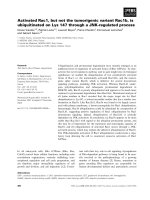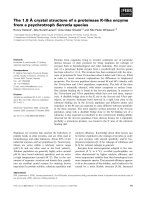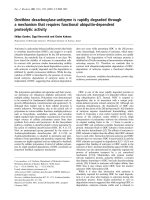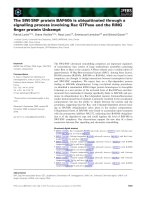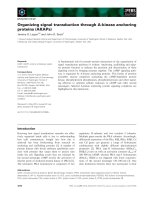Xrays passed through a crystal
Bạn đang xem bản rút gọn của tài liệu. Xem và tải ngay bản đầy đủ của tài liệu tại đây (2.2 MB, 21 trang )
XRD METHOD
I. DEFINITION AND PRINCIPLE
II. SOME APPLICATIONS
I. DEFINTION AND PRINCIPLE
What is X-ray diffraction?
X-rays passed through a crystal will be bent at
various angles. The process by which the bending
occurs is called diffraction. The angle at which Xrays are diffracted is dependent upon the distance
between adjacent layers of atoms or ions. X-rays
that strike adjacent layers can add their energies
constructively when they are in-phase. This
produces dark dots on the detector plate
.
By rotating the sample, ciruclar patterns of
diffracted X-rays are created
.
The distance “R” between the center of the ring and
a dark dots is used to calculate th distance between
adjacent layers in the crystal
.
Bragg’s Law
II. SOME APPLICATIONS
1. Distribution of atoms in the unit cell, i.e. the crystal structure,
either to verify that the material has one of the already known
types of crystal structures or to solve it from first principle.
2. Phase composition of a material, including both qualitative and
quantitative analyses coupled with searches of various databases.
XRD is a useful technique to determine the distance between layers of atoms
or ions in crystalline materials. The X-ray pattern that is produced is unique
to the crystal and can be used to identify the components of the crystal and its
crystal structure. The information from the length of a crystal’s unit cell can
be used to detremine the density of compounds
.
.
Measuring the length of crystal’s unit cell
Phase identification and analysis
Each powder diffreaction pattern is characterized y a unique distribution of both
positions and intensities of Bragg peak, where peak positions are defined by the
unit cell dimensions and reflection intensities are stablished by the distribution
of atoms in the unit cell of every crystalline phase present in the sample. Thus,
every individual crystalline compound has its own “fingerprint”, which
enables the utilization of powder diffraction data in phase identification
XRD – LaMnO3 (STANDARD SAMPLE)
XRD – THE SYNTHESIZED SAMPLE
The column containing full widths
at haft maximum of the observed
Bragg peak is a useful tool in
deciding whether or not the final
differences between the observed
and calculated Bragg angles are
satisfactory
.
Quantitative analysis
Quantitative phase analysis is used to determine the concentration of verious
phases that are present in a mixture after the identity of every phase has been
established.
This equation makes use of the fact that the scattered intensity is
proportional to the amount of a particular phase.
THE END
THANK YOU
FOR YOUR ATTENTION



